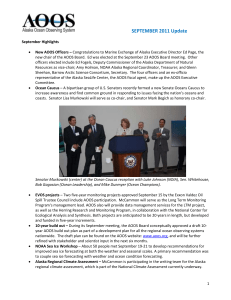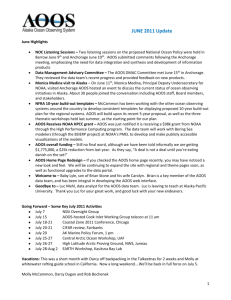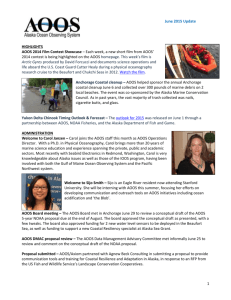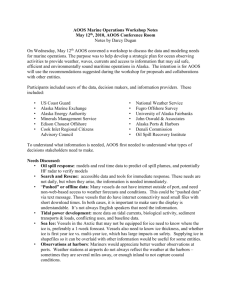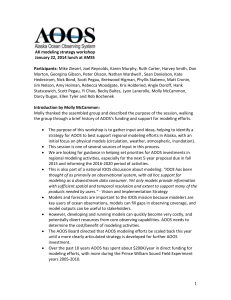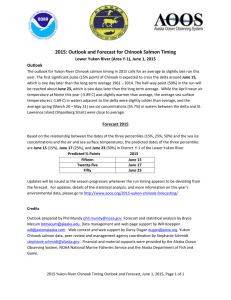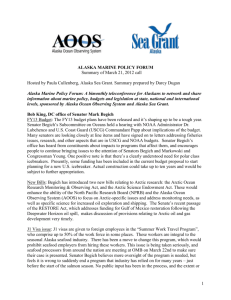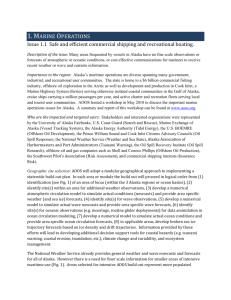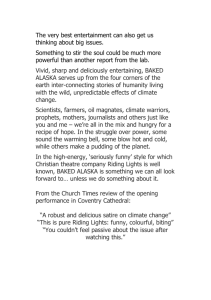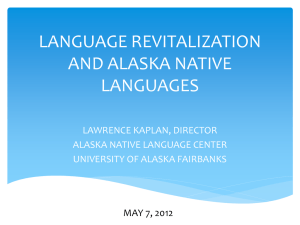Meeting summary - Alaska Ocean Observing System
advertisement
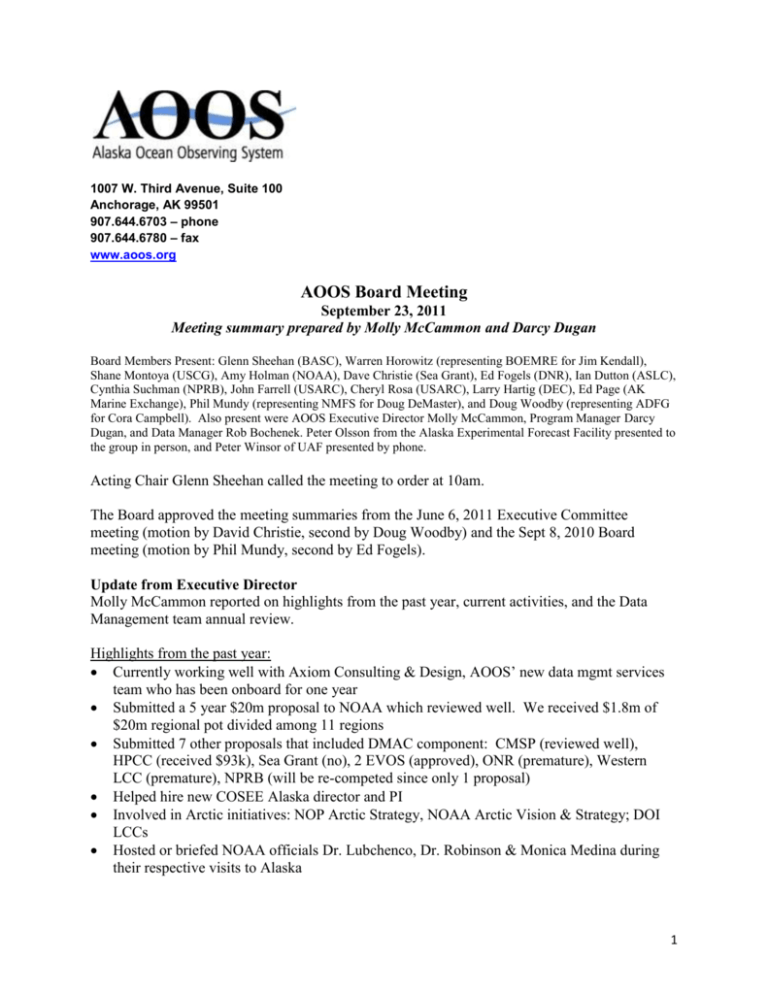
1007 W. Third Avenue, Suite 100 Anchorage, AK 99501 907.644.6703 – phone 907.644.6780 – fax www.aoos.org AOOS Board Meeting September 23, 2011 Meeting summary prepared by Molly McCammon and Darcy Dugan Board Members Present: Glenn Sheehan (BASC), Warren Horowitz (representing BOEMRE for Jim Kendall), Shane Montoya (USCG), Amy Holman (NOAA), Dave Christie (Sea Grant), Ed Fogels (DNR), Ian Dutton (ASLC), Cynthia Suchman (NPRB), John Farrell (USARC), Cheryl Rosa (USARC), Larry Hartig (DEC), Ed Page (AK Marine Exchange), Phil Mundy (representing NMFS for Doug DeMaster), and Doug Woodby (representing ADFG for Cora Campbell). Also present were AOOS Executive Director Molly McCammon, Program Manager Darcy Dugan, and Data Manager Rob Bochenek. Peter Olsson from the Alaska Experimental Forecast Facility presented to the group in person, and Peter Winsor of UAF presented by phone. Acting Chair Glenn Sheehan called the meeting to order at 10am. The Board approved the meeting summaries from the June 6, 2011 Executive Committee meeting (motion by David Christie, second by Doug Woodby) and the Sept 8, 2010 Board meeting (motion by Phil Mundy, second by Ed Fogels). Update from Executive Director Molly McCammon reported on highlights from the past year, current activities, and the Data Management team annual review. Highlights from the past year: Currently working well with Axiom Consulting & Design, AOOS’ new data mgmt services team who has been onboard for one year Submitted a 5 year $20m proposal to NOAA which reviewed well. We received $1.8m of $20m regional pot divided among 11 regions Submitted 7 other proposals that included DMAC component: CMSP (reviewed well), HPCC (received $93k), Sea Grant (no), 2 EVOS (approved), ONR (premature), Western LCC (premature), NPRB (will be re-competed since only 1 proposal) Helped hire new COSEE Alaska director and PI Involved in Arctic initiatives: NOP Arctic Strategy, NOAA Arctic Vision & Strategy; DOI LCCs Hosted or briefed NOAA officials Dr. Lubchenco, Dr. Robinson & Monica Medina during their respective visits to Alaska 1 Highlights of Current Activities Arctic: continuing Arctic Asset mapping Participating in industry data sharing agreements with NOAA, Shell, ConocoPhillips, Statoil Developing a Cook Inlet ERMA prototype, integrating data for oil spill response Launching ADF&G Data Partnership, initially focused on the Bristol Bay region Designing 10-year Build out for a bare-bones AOOS observing system; to be submitted to national IOOS program Adding new observing platforms: Cook Inlet wave buoy at Anchor Point; weather station at McNeil River (installation delayed until next spring); Arctic glider flying in Chukchi; OA sensors in Beaufort & GAK mooring AK Marine Policy Forum – hosting calls every other month; gaining popularity Northern Waters Task Force; McCammon has attended and presented at several meetings Alaska Regional Climate Assessment: McCammon is part of writing team EVOS Long Term Monitoring and Herring projects – won proposals; will be lead data managers in multi-partner projects, which involves a lot of synthesis Data Management Team Review McCammon reported on the data management team review which was conducted in August. Angel Corona, Steve Lewis, and Phil Mundy from the AOOS Data Management Advisory Panel helped her in reviewing the first year of Axiom’s 5-year contract. Overall, AOOS and partners are very pleased with progress in year 1, and had only some minor recommendations. The contract for the second year is underway. Users/Stakeholders Discussion The Board discussed how to craft the most effective user/stakeholder process for AOOS. Two years ago the AOOS Board adopted the Terms of Reference for a formal statewide stakeholder/user advisory panel, but it has yet to be implemented. As one of the IOOS regional associations, AOOS is required to have some form of stakeholder/user advice. This can take a form decided on by the region – either a formal committee or advisory panel, periodic workshops, targeted outreach, surveys, etc. It has been difficult to know how formal committees and panels would work for AOOS – whether they should be geographically or thematically based, and whether they should consist only of stakeholders, or also include science and technical folks. In addition, a number of new organizations have been created with their own stakeholder advisory groups. There is concern of creating advisory panel burnout. Other regional associations seem to have had the most success with committees that include a mix of stakeholders, scientists and technical experts. The three workshops sponsored by AOOS in 2010 used such a mixture of participants, organized around priority themes (marine operations, coastal hazards and climate trends/ecosystems), and these were well received. Based on this discussion, the AOOS Board recommended that instead of moving forward with a statewide formal stakeholder/user advisory panel, AOOS should establish smaller advisory panels following the general themes (marine operations, coastal hazards, and climate trends/ ecosystems) and consisting of a mix of stakeholders and scientists. These groups would be mission-focused with specific issues drawing people to the table, and the Board could help define the questions that needed to be answered. This would create an interactive mechanism between the Board and the advisory process. It was discussed that perhaps 8-10 people from 2 each of the theme groups would meet once a year or as needed, with the ability to revise this process as ideas and goals changed. Motion: to will rescind its past action in creating a statewide stakeholder advisory committee, and instead, adopt a formal stakeholder “policy” and process that would incorporate smaller working groups made up of both stakeholders and scientists/technical experts to provide advice as needed. The AOOS Director will develop a draft policy and circulate it to the full board for comment by email, and bring it to the Executive Committee or the full AOOS Board for action. (Motion by Ed Page, seconded by Phil Mundy and amended by Dave Christie). The motion passed unanimously. AOOS Standard Operating Procedures Adoption The Board reviewed the changes that had been made to the AOOS Standard Operating Procedures (SOP) during the November 2009 board meeting. The changes had been previously approved, but hadn’t been formally adopted in final draft. They were fairly standard and most of the information in the SOP had been in the original MOU that Board members had signed. Motion: to adopt the finalized SOP with one change, adding the word “May” to section 7(a) to read “the Board may appoint advisory panels” (motion by Ed Page, second by Dave Christie). Adopted unanimously. Board Request: During discussion, it was noted that there had been conversation about the roles and responsibilities of the Alaska Sea Life Center as the fiscal agent for AOOS. A formalized agreement needs to be drafted and brought back to the board. Board Request: Post the updated SOP as well as the MOU to the AOOS website. Election of Officers Ian Dutton reported on behalf of the nominating committee, on which he served along with Nancy Bird and Amy Holman. The committee recommended the slate of officers listed below. They recommended considering (but not requiring) having either the Board chair or vice chair close to Anchorage to facilitate chairing meetings, especially those held by teleconference, and that the suite of officers represent a balance of federal agency, state agency, and NGO members. They also prioritized balancing between new and experienced Executive Committee members. Nominating Committee recommendations: Chair: Ed Page, Marine Exchange of Alaska (NGO) Vice Chair: Ed Fogels, Alaska Department of Environmental Conservation (state) Secretary: Glenn Sheehan, Barrow Arctic Science Consortium (research NGO) Treasurer: Amy Holman, NOAA (federal) Motion: to adopt the Nominating Committee’s recommendations for officers for the next two years, 2011-2013 (motion by Doug Woodby, second by Cheryl Rosa). Motion approved unanimously. The chairmanship was transferred to Ed Page who led the rest of the meeting. 3 Board Appointment to NFRA Each regional ocean observing system has two designees, but one vote, to the National Federation of Regional Associations for Coastal and Ocean Observing (NFRA) board. In the past, this has been the Executive Director and Nancy Bird. This role involves attending two board meetings per year although attendance by the same individual isn’t mandatory and various members have filled in for Bird. Since Bird is leaving the Prince William Sound Science Center in December and will no longer be on the AOOS Board after that, McCammon recommended the Executive Director and the Board chair be the formal designated members. This was agreed to by the board unanimously for the next two years. Wind Modeling– presentation and update by Peter Olsson, AEFF Peter Olsson, chief scientist of the Alaska Experimental Forecast Facility and State Climatologist, briefed the AOOS board on numerical wind modeling efforts in southcentral Alaska funded by AOOS. Peter runs a WRF model which provides a variety of weather forecasting parameters in addition to wind. WRF is world standard for meso-scale models, and Peter’s model is a 2-grid domain (4km within 12km master grid) with highest resolution in Prince William Sound. He has three models that he runs twice a day, providing 48 hour predictions. Olsson has been collaborating and sharing his model output with the NWS forecast office. There were some initial technical complications, but the data sharing structure is now in place. He is currently waiting on NWS to let him know which files they want (otherwise his model output is too big). McCammon noted that wind forecasts are especially important because they feed the other ocean models. Olsson said he is also working with the Anchorage Municipality to better understand Anchorage air quality. Sometimes the city does not meet air quality standards when northerly wind events blow glacial till from Knik Arm into Anchorage. Olsson’s research may help predict these events and allow Anchorage to get an exemption waiver. Activities in Cook Inlet and the Arctic Darcy Dugan provided an update on the Cook Inlet Modeling Working Group which has been meeting by teleconference every other month since the Cook Inlet modeler’s workshop in March 2010. The group provides a forum for modelers to network, discuss model development, and share model input and output. Dugan noted recent developments in the NOAA-funded Cook Inlet circulation modeling effort that is looking at water level, currents, temperature, and salinity. That effort also produced a ‘best bathymetry’ dataset that is useful to a wide range of scientists and will be available on the AOOS website. A new Cook Inlet regional page will soon be launched on the AOOS website with information on models and recent activities. The region was also highlighted in the AOOS summer newsletter. On the Arctic front, AOOS continues to maintain the Arctic Research Assets map which shows the locations and metadata for instruments, transects and monitoring platforms in the Beaufort and Chukchi Seas. AOOS also set up a ‘cruise plan coordinating page’ this spring for the first time to help researchers collaborate and make better use of ship time. Dugan noted an upcoming project in partnership with UAF to create an interactive electronic sea ice atlas with digitized maps and sea ice climatologies from the past 60 years for Alaska waters. 4 Data Management Update Rob Bochenek, AOOS data manager, provided an update on recent advances of the AOOS data portal. He explained the High Performance Computing Cluster (HPCC) approach which allows AOOS to pull in and display data from many different agencies almost instantaneously. He provided a tour of the AOOS Real Time Sensor Map and Model Explorer, including the ‘virtual sensor’ function. Bochenek’s team is currently working to design the “Alaska Ocean Portal” which will allow users to combine real-time sensors, models, GIS layers, in-situ observations, and satellite imagery on a common interface. They are also developing an “Alaska Ocean Workspace”, where PIs can upload and their own data and create their own metadata which can then be accessed by others. Update on ACT – Alliance for Coastal Technology – in Alaska Peter Winsor, professor and scientist at UAF, provided an update from ACT. ACT is a partnership of research institutions, resource managers, and private sector companies dedicated to fostering the development and adoption of effective and reliable sensors and platforms for use in coastal, freshwater and ocean environments. It is a NOAA-funded program that sits under IOOS, and provides a foundation for IOOS and others to understand what kind of technology they’re using. In Alaska, ACT worked with Jeremy Mathis and AOOS to install a number of CO2 sensors on the GAK1 mooring in Resurrection Bay. This will be a long term test of various pCO2 sensors, since many sensors don’t work in Alaska the way they do elsewhere (for example, the world standard for ocean acidification isn’t working well in Alaska). Winsor mentioned they often educate the manufacturers on how their own products work. Winsor’s team is currently trying to turn over a set of OA sensors off a buoy in the Chukchi, but they are waiting on weather. ACT is working with IOOS to look at what sensors to evaluate next year. AOOS glider update: The glider that AOOS purchased last year for use by UAF is running transects in the Klondike lease patch in the Chukchi Sea. In the next week, Winsor will swim it back to Wainwright before the winter storm season. The glider has been out for two months and covered a significant amount of ground. ANT glider update: The Alaska Native Technology company produced 22 ‘jumbo gliders’ as part of an 8(a) contract with the Office of Naval Research. The gliders are currently in storage since there was money to produce them but not to apply them. The gliders have been used in some field trials by engineers, but not scientists. BOEMRE is interested in getting them up and running in the Arctic, but they are built with standard engineering and not designed for the strong stratification and currents found in the Arctic. Winsor would like to instrument one of the gliders and test it on runs from Nome, through the Bering Strait and the Chukchi Sea to Barrow. Dave Christie noted the need for software development to bring the ANT gliders up to standard. He thought a run from Nome to Barrow would be great for getting publicity as well as a paper in Nature that could bring in additional grant money. He thought it would take approximately $3040k to instrument the glider, and at least $200k for a project to test it. AOOS 10-yr Build out Draft AOOS consultant Carl Schoch presented the draft conceptual10-year AOOS build out that will be submitted to the national IOOS office this fall. The IOOS regions were asked to develop 10- 5 year build out plans to ensure initial, barebones capabilities to address regional priority needs. These plans will be used to help fulfill the ICOOS Act requirements of an independent cost estimate and annual regional gaps analysis, and also provide information for the National Ocean Policy #9: “Strengthen and integrate Federal and non-Federal ocean observing systems, sensors, data collection platforms, data management, and mapping capabilities into a national system and integrate that system into international observation efforts.” Schoch worked within the constraints of Alaska’s broad geography, the guidelines set forth by IOOS, and the feedback provided from three thematic workshops held in 2010 with stakeholder and scientist participation that identified Alaska observing and information priorities. There is no cap on total cost of implementation at this stage. **The full draft plan can be accessed on the AOOS website. ** The broad priorities are: 1. Marine Operations a. Weather and sea state communication via improved AIS b. Real-time harbor weather and currents c. Forecasts of sea ice drift trajectory, floe density, thickness 2. Climate variability and change/ Water quality, Ecosystem Health, and Fisheries a. Annual state of the oceans synthesis b. GOA: GAK1 and glider line, OA, HABs c. Bering Sea: PMEL moorings (e.g. M2), OA, climate change d. Arctic: ice mapping, drift trajectory forecasts, mooring, DBO 3. Coastal Hazards a. Storm forecasts, waves, surges, inundation, erosion, ice b. High resolution digital shoreline, bathymetry, DEMs c. Real-time harbor weather The Alaska Region is organized around the 3 Large Marine Ecosystems, 7 sub-regions and 15 ‘areas’. The Board discussed these questions and issues: Funding mechanisms and ‘implementing’ agencies are not specified in the plan. Partnerships can grow out of this build out. The make-up of the AOOS board across sectors helps make this environment of partnerships possible. Size and amount of build out o How do we know what’s ‘bare bones’ and whether our plan is too much or not enough? 6 o The number of areas we cover is scalable. We can add areas if it looks like we’re coming in too cheap. o Perhaps there are in reality five LME’s instead of three. Each of our areas is larger than some of the lower 48 regions. o There’s only one area in southeast Alaska. There should be four. How will IOOS synthesize these plans? o All regions are using the same template and a standard list of terms. Two contractors have been hired to help synthesize these. They’ll take a look at all 11 plans and ‘massage’ the outliers. The synthesis will reflect the regional differences in building a national system that fulfills national objectives in the diverse regions of the country. The synthesis will represent the base observing capacity the nation needs to address critical gaps. We are making the assumption that federal assets will be maintained. We are also assuming we have adequate agency surveys of fish, birds, and mammals. Motion: to commend Schoch on producing an excellent first draft to submit next week in draft form and also to modify the design to organize the 3 regions (Gulf, Bering, and Arctic) into 7 subregions (2 in Gulf, 3 in Bering, 2 in Arctic) and 15 areas (by Holman, second by Mundy). Motion passed unanimously. Next steps for the build out: o Schoch will ensure the Board gets a copy of the final draft o National contractors will take 11 plans and synthesize/integrate them o The regional workshop in November will be devoted to continued work on these plans o The draft plans will be finalized by end of December, and published by mid January o The regions can use the plans for their own regional planning efforts. AOOS will use it as an outreach tool, soliciting feedback and looking for partnerships. o Following review and input from stakeholders, the AOOS Board will reconsider the draft plan for possible modifications. o The board will look at strategies for implementation. The Board adjourned at 4:30pm. 7
